A bioluminescent probe for imaging endogenous hydrogen polysulfides in live cells and a murine model of bacterial infection†
Abstract
In this work, we report the first bioluminescent probe BP-PS for detecting H2Sn with high specificity and sensitivity. Owing to the bioluminescence imaging without requiring an excitation light source, tissue autofluorescence is eliminated and BP-PS shows a high signal-to-noise ratio. Moreover, BP-PS was successfully utilized to visualize endogenous H2Sn in live cells and a murine model of bacterial infection.



 Please wait while we load your content...
Please wait while we load your content...